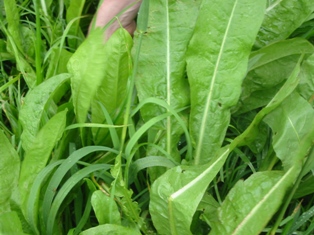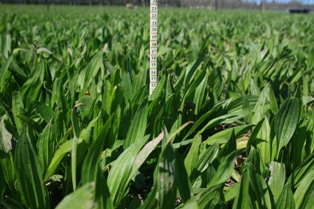Grazing herbs are plant species that are often mistaken by many farmers as weeds in their pasture. An ideal pasture contains a large proportion of vigorous grasses and to a lesser extent companion species such as clover and herbs.
Grazing herbs include both Chicory (Cichorium intybus) and Plantain (Plantago lanceolata). These are perennial plants that in some harsh environments behave as free seeding annuals, that is, they grow for one year or less, set seed and die.
Chicory
Chicory is a native to Europe, Asia and North Africa, actively growing in spring, summer and autumn with winter dormancy. It has a taproot with an exposed crown and rosette of large upright leaves. Chicory prefers deep, fertile, and free draining soils (similar to lucerne), however, it does have tolerance to soil acidity. Minimum average annual rainfall for optimum growth and survival is 650-750mm. Sowing can occur in either autumn or spring with sowing rates varying in pastures mixes from 0.5-2.0kg/ha.
Chicory is known to contain both minerals (potassium, magnesium, calcium, sulphur) and trace elements (copper, zinc) that are beneficial to livestock health. It is also reported to have an anthelmintic effect (expels parasitic worms from the body) on sheep and deer, although this is untested in other livestock.

Plantain
Plantain is a deep rooted perennial herb, native to Europe, Asia and North Africa. Similar to chicory it grows from a rosette, however, its leaves are ribbed, with fine hairs and a sharp point. Developed from the well known flat weed, plantain grows all year round and in contrast to chicory has strong winter growth.
It is suited to a wide range of soil types, including low fertility and has good tolerance to soil acidity. Minimum average rainfall for optimum growth and survival is 600-700mm. Sowing can occur in autumn or spring where high rainfall or irrigation is available. Sowing rates vary in pasture mixes from 1-3kg/ha.
Plantain also contains high levels of minerals (calcium, magnesium, sodium, phosphorus, cobalt) and trace elements (zinc, copper, selenium). Sheep grazing trials have shown significant increases in both copper and selenium uptake. Again, this is untested in other livestock. Plantain has also shown some evidence of containing desirable levels of condensed tannins (plant protein protected from microbe breakdown), along with anti-microbial (substances that inhibit growth of microorganisms) and anthelmintic properties.
 |
Management
Both chicory and plantain can be difficult to manage and are best controlled by rotational grazing. Under close, hard grazing by sheep and horses they can be preferentially grazed and therefore grazed out. Under lax grazing chicory bolts quickly during the spring sending up tall stems which can become woody and unpalatable. Stem elongation can be controlled during the warm months of the year, by short and sharp grazing events when stems have ten percent or fewer flowers. If few livestock are available, paddocks containing herbs should be grazed, topped with a slasher and then rested.
Grazing herbs are not legumes; therefore they do not fix their own nitrogen. Pastures with these species require clovers (subterranean, white clover) for their nitrogen fixing capabilities or alternatively require applications of nitrogen fertiliser to maximise growth.
Chicory and plantain are suitable for hay, however the leaves of these species are slow to dry which can delay the haymaking process. Be aware that grazing herbs are particularly susceptible to phenoxy-based herbicides (e.g. MCPA and 2,4-D). Therefore, paddocks where herbs are to be sown should be free of broadleaf weeds. If broadleaf weeds are anticipated to be a problem, herbs can be added to the pasture at a later point, broadcast with fertiliser and trampled in.
In summary, grazing herbs are fascinating plants and although often only used as companion species in pasture mixes, their growth habit, benefits, pitfalls and management are still worthwhile understanding. Farmers who can recognise grazing herbs in their pastures will quickly realise that these plants are in- fact not weeds but useful pasture species.
Where to from here?
For further information on pastures we recommend you purchase a copy of AgGuide - Pastures in a farming system covers where pastures fit in a farming system for livestock, cropping and the environment.
About the author
The author Charlie Roberts is one of the FarmStyle Australia experts, he runs this website and has a Bachelor of Farm Management and a Masters of Business Administration. He has worked for a number of agricultural companies in both New Zealand and Australia. He has a wealth of experience working with farmers in a range of environments.



